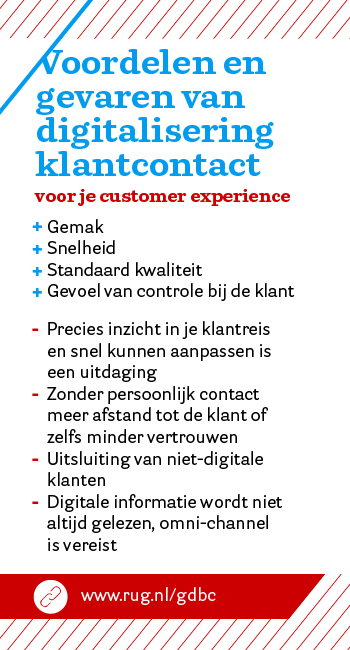BLOG | Four advantages & four risks of digitisation of customer contact
Author: Peter Verhoef, Professor of Marketing RUG, director University of Groningen Business School and director Groningen Digital Business Centre.

More and more businesses are digitising their contacts with customers. And more and more customers are using digital channels, especially mobile channels, at the expense of other forms of contact. Banks too, are seeing an increase in the use of mobile payment apps. It is convenient and fits in modern lifestyles, where mobile phones have almost become a part of the body. Banks are responding with new social payment services, like ABN AMRO’s Tikkie and social payment options in the Rabo app. I recently started using these services and they are really easy to use.
Easy and fast
Why are digital services so valuable for customers? Ease of use is an important advantage. As a customer, you can take care of business where and whenever you want. It is often faster too. In addition, an important advantage is the standardisation in service. Service provided by personnel may vary. Where one telephone service employee may provide excellent service, the other may treat customers badly. In digital service, everything is automatic and standardised. When the processes have been directed and configured in a customer-oriented manner, this will ensure good service.
Notorious
Naturally, there are examples where things did not or do not go according to plan. Ryanair, for instance, was notorious for its rather customer-unfriendly flight booking process. But even Ryanair is learning, and during my last booking the process had become much easier. (Though we still have to make do with insufficient explanation from the airline company about where to enter the names of the adults (including our teenage daughter) and the names of the children.)
Another advantage is giving your customers a sense of control. Personal service is about yielding control of a number of matters, whereas digital service gives the customer a custom-made feeling. In general, customers seem to prefer this because you are not at the mercy of the service employee.
A recent discussion I had with a representative of the Chamber of Commerce revealed that digitisation can contribute positively to the customer experience. He indicated that customer satisfaction about the Chamber had increased considerably after a digital overhaul. They offer more digital services through a portal (ondernemingsplein.nl) and developed short online videos and MOOCs, for instance. This digital overhaul, however, did entail the laying off of a considerable number of consultants.
Dangers
Yet there is criticism and there are concerns about the increasing digitisation of services. There are most definitely dangers. Firstly, digital service must be set up with real customer-orientation, with strong knowledge of the “journey” that the customers make when they use your services. This means having insight into how customers use services. It also means that digital service needs to be monitored continuously and adjusted in real time wherever necessary.
Lower loyalty
Secondly, digital service means less and less actual personal contact between the customer and the company. Especially extraordinarily customer-oriented employees can make the difference with their empathetic and decisive attitude. Furthermore, the distance experienced between the customer and the company only becomes larger, which can lead to decreased faith and lower loyalty. The renowned management guru Simon Zinek warns society that increasing digitisation may contribute to decreased faith in important institutions, such as banks, the government and other bodies.
The elderly and banking
Thirdly, an important problem of increasing digitisation is that a large group of customers cannot or will not keep up, commonly known as digital illiterates. This discussion is often most poignant when bank branches are closed. Banks often do this because of cost considerations, but also because more and more customers use digital banking and visit the branches less and less. But how do the elderly, with or without mobility issues, take care of their bank business otherwise? This leads to digital ostracisation for a large group of customers!
Not just the elderly
There are great concerns about a digitising government. Digitisation may cause vulnerable groups to make even less use of all kinds of relevant allowances and regulations. This not only concerns the digitally illiterate. Research shows, that there is a large group of customers (around 30%) who have a strong preference for non-digital channels and do not want to use digital channels. These are the customers that really want to be served personally.
Spam
Fourth, we must be concerned about the effectiveness of the provision of information through digital channels. Businesses incorrectly think that by sending an email or placing a message in an inbox, they are informing their customers sufficiently. Every customer will recognise this: updates from companies end up in the spam box or are simply not read. The bank’s message service, as a rule, contains many unread messages. I myself, for instance, found out way too late that my mortgage payments to the Rabobank had to be made through a new digital portal. I had failed to read a message in the mailbox. The government is taking an extremely great risk in putting so much faith in digitisation through mijnoverheid.nl for their communication with citizens. An omni-channel strategy aimed at communication through different channels, adjusted to the target group, is the solution.
Strategy
As our great Dutch footballer/philosopher Johan Cruyff already said, every upside has its downside. This also applies to digitisation. Digitisation, when used correctly, can contribute to a much better customer experience for the contemporary consumer. Advancing technology and integration of social media, will only increase the possibilities for this. Despite this, we must not close our eyes to the dangers of customer experience, customer faith and loyalty. These require a clear strategy from companies where the customer comes first and the focus lies beyond the company’s own economic interests.

Further information:
More news
-
15 September 2025
Successful visit to the UG by Rector of Institut Teknologi Bandung

